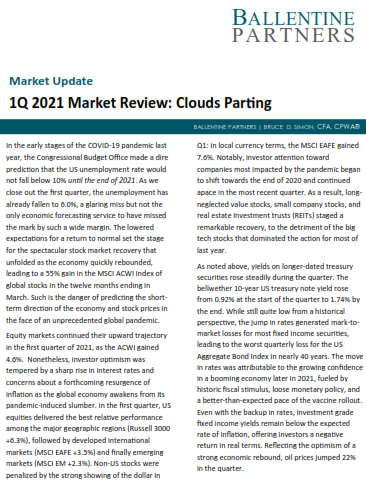Market Recap
In the early stages of the COVID-19 pandemic last year, the Congressional Budget Office made a dire prediction that the US unemployment rate would not fall below 10% until the end of 2021. As we close out the first quarter, the unemployment has already fallen to 6.0%, a glaring miss but not the only economic forecasting service to have missed the mark by such a wide margin. The lowered expectations for a return to normal set the stage for the spectacular stock market recovery that unfolded as the economy quickly rebounded, leading to a 55% gain in the MSCI ACWI Index of global stocks in the twelve months ending in March. Such is the danger of predicting the short-term direction of the economy and stock prices in the face of an unprecedented global pandemic.
Equity markets continued their upward trajectory in the first quarter of 2021, as the ACWI gained 4.6%. Nonetheless, investor optimism was tempered by a sharp rise in interest rates and concerns about a forthcoming resurgence of inflation as the global economy awakens from its pandemic-induced slumber. In the first quarter, US equities delivered the best relative performance among the major geographic regions (Russell 3000 +6.3%), followed by developed international markets (MSCI EAFE +3.5%) and finally emerging markets (MSCI EM +2.3%). Non-US stocks were penalized by the strong showing of the dollar in Q1: in local currency terms, the MSCI EAFE gained 7.6%. Notably, investor attention toward companies most impacted by the pandemic began to shift towards the end of 2020 and continued apace in the most recent quarter. As a result, long-neglected value stocks, small company stocks, and real estate investment trusts (REITs) staged a remarkable recovery, to the detriment of the big tech stocks that dominated the action for most of last year.
As noted above, yields on longer-dated treasury securities rose steadily during the quarter. The bellwether 10-year US treasury note yield rose from 0.92% at the start of the quarter to 1.74% by the end. While still quite low from a historical perspective, the jump in rates generated mark-to-market losses for most fixed income securities, leading to the worst quarterly loss for the US Aggregate Bond Index in nearly 40 years. The move in rates was attributable to the growing confidence in a booming economy later in 2021, fueled by historic fiscal stimulus, loose monetary policy, and a better-than-expected pace of the vaccine rollout. Even with the backup in rates, investment grade fixed income yields remain below the expected rate of inflation, offering investors a negative return in real terms. Reflecting the optimism of a strong economic rebound, oil prices jumped 22% in the quarter.
Outlook and Strategy
The stage is set for a historic economic boom in the second half of 2021, as the liquidity created by the Biden administration’s fiscal stimulus package courses through the American economy. Consensus expectations for 2021 real GDP growth are in the 7% range, followed by a “soft landing” back to the traditional 2-2.5% annual growth experience of the US economy for the last twenty years or so.
As the US approaches herd immunity, a significant economic setback before then seems highly unlikely. Not so in Europe, where the slow vaccine rollout is prompting calls for new lockdowns from government leaders. China’s economy has already recovered all the lost output it sustained during the early stages of the crisis, so its future relative growth may be less dramatic than economies in earlier stages of recovery. Our recommended geographic equity allocation to overweight US, underweight Europe, and maintain a neutral posture toward emerging markets broadly reflects these diverging trends.
To divine the market’s next move, US-focused equity investors need to address the following three questions: 1) how much of the upcoming economic boom is already reflected in stock prices: 2) how high can interest rates go; and: 3) what does the trajectory of economic growth look like once the boom subsides? We believe that investors have largely incorporated the coming economic boost in current prices, so gains from here are likely to gradual and hard-fought. While we do expect a meaningful jump in inflation over the next few quarters, we believe the larger demographic forces that have kept inflation under control for the last decade are likely to reassert themselves once the boom subsides.
Earnings comparisons in 2022 will be more challenging given this year’s sharp rise. Consensus earnings are expected to show a 40% boost in 2021 over depressed 2020 data, and a further 16% increase in 2022. Even accounting for analysts typical overly optimistic forecasts, this should provide support for equity prices.
In short, we continue to view stocks as attractive and recommend that clients maintain a modest overweight position relative to their strategic targets. Even with the recent backup in interest rates, high quality bonds offer little or no return after the effects of inflation. At some point, however, attention will shift to 2022, when a slowing economy, higher interest rates, and potentially higher taxes will confront investors. In the meantime, we see nothing on the horizon that could result in a severe bear market decline. As the economic clouds part, the outlook looks bright.
About Bruce D. Simon, CFA, CPWA®
Bruce is a Partner and the Director of Research at the firm. In addition to working directly with a number of family clients, Bruce serves on Ballentine’s Investment Management Committee, which is responsible for the oversight of all of the investment activities for the firm.
This report is the confidential work product of Ballentine Partners. Unauthorized distribution of this material is strictly prohibited. The information in this report is deemed to be reliable but has not been independently verified. Some of the conclusions in this report are intended to be generalizations. The specific circumstances of an individual’s situation may require advice that is different from that reflected in this report. Furthermore, the advice reflected in this report is based on our opinion, and our opinion may change as new information becomes available. Nothing in this presentation should be construed as an offer to sell or a solicitation of an offer to buy any securities. You should read the prospectus or offering memo before making any investment. You are solely responsible for any decision to invest in a private offering. The investment recommendations contained in this document may not prove to be profitable, and the actual performance of any investment may not be as favorable as the expectations that are expressed in this document. There is no guarantee that the past performance of any investment will continue in the future.




